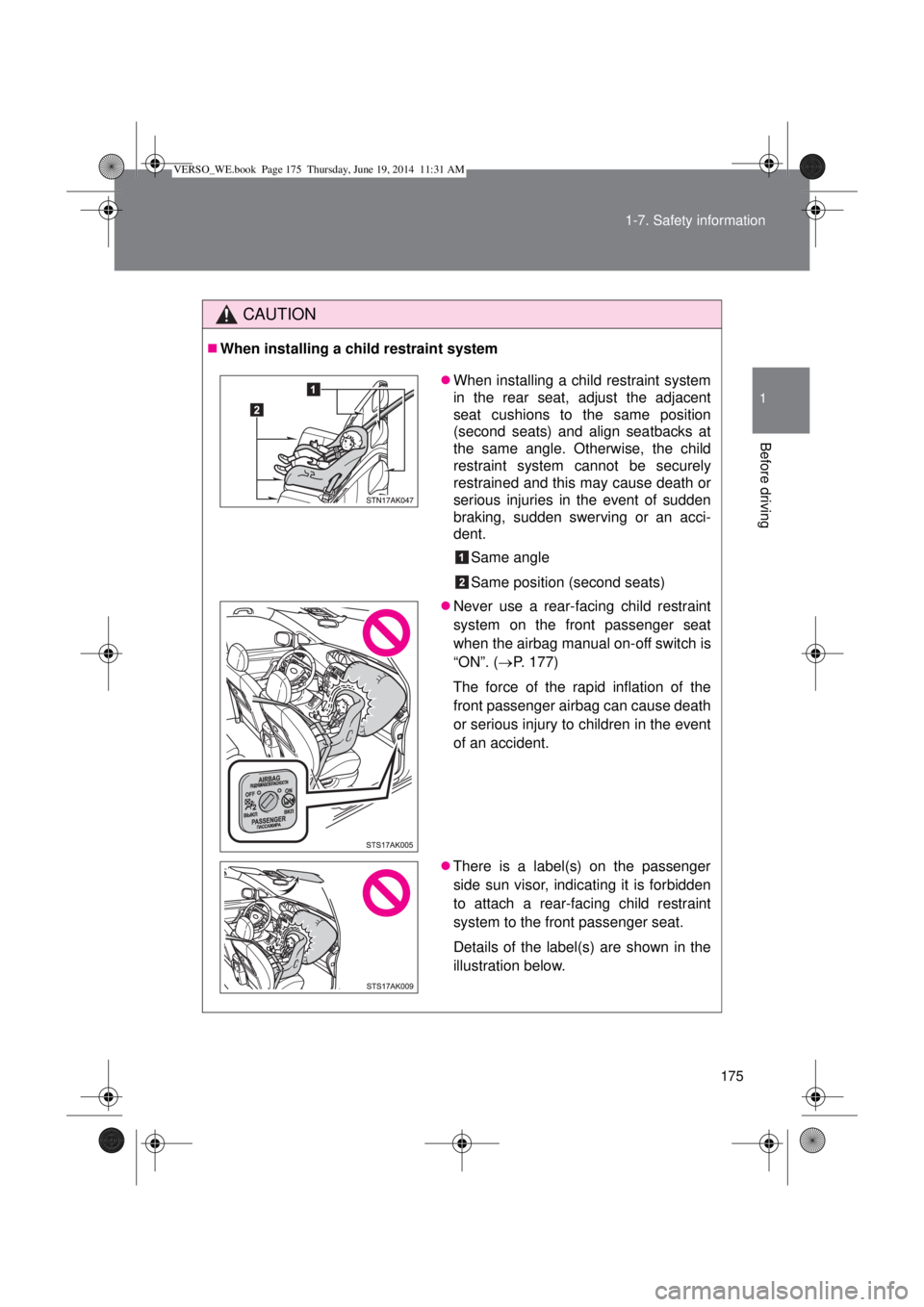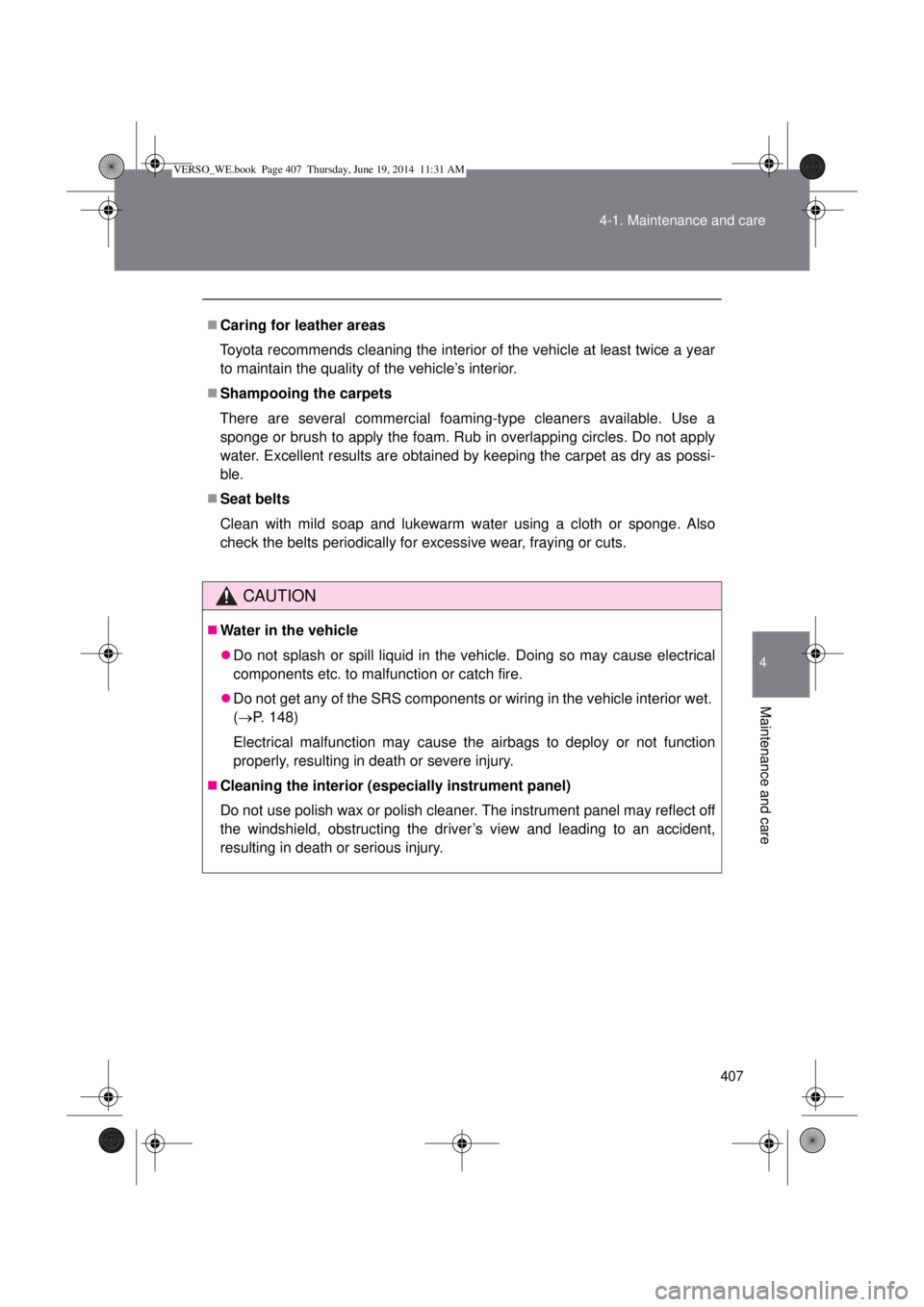Page 175 of 650

175 1-7. Safety information
1
Before driving
CAUTION
When installing a child restraint system
When installing a child restraint system
in the rear seat, adjust the adjacent
seat cushions to the same position
(second seats) and align seatbacks at
the same angle. Otherwise, the child
restraint system cannot be securely
restrained and this may cause death or
serious injuries in the event of sudden
braking, sudden swerving or an acci-
dent.
Same angle
Same position (second seats)
Never use a rear-facing child restraint
system on the front passenger seat
when the airbag manual on-off switch is
“ON”. (P. 177)
The force of the rapid inflation of the
front passenger airbag can cause death
or serious injury to children in the event
of an accident.
There is a label(s) on the passenger
side sun visor, indicating it is forbidden
to attach a rear-facing child restraint
system to the front passenger seat.
Details of the label(s) are shown in the
illustration below.
VERSO_WE.book Page 175 Thursday, June 19, 2014 11:31 AM
Page 177 of 650
177
1
1-7. Safety information
Before driving
Airbag manual on-off system
This system deactivates the front passenger airbag.
Only deactivate the airbags when using a child restraint system on
the front passenger seat.
Vehicles with manual air conditioning system
“PASSENGER AIRBAG”
indicator
Vehicles without smart entry &
start system: This indicator
light turns on when the airbag
system is on (only when the
engine switch is in the “ON”
position).
Vehicles with smart entry &
start system: This indicator
light turns on when the airbag
system is on (only when the
“ENGINE START STOP”
switch is in IGNITION ON
mode).
Airbag manual on-off switch
VERSO_WE.book Page 177 Thursday, June 19, 2014 11:31 AM
Page 178 of 650
178 1-7. Safety information
Vehicles with automatic air conditioning system
“PASSENGER AIRBAG”
indicator
Vehicles without smart entry &
start system: This indicator
light turns on when the airbag
system is on (only when the
engine switch is in the “ON”
position).
Vehicles with smart entry &
start system: This indicator
light turns on when the airbag
system is on (only when the
“ENGINE START STOP”
switch is in IGNITION ON
mode).
Airbag manual on-off switch
VERSO_WE.book Page 178 Thursday, June 19, 2014 11:31 AM
Page 179 of 650
179 1-7. Safety information
1
Before driving
Deactivating the front passenger airbag
Vehicles without smart entry &
start system: Insert the key into
the cylinder and turn to the
“OFF” position.
The “OFF” indicator light turns on
(only when the engine switch is in
the “ON” position).
Vehicles with smart entry & start
system: Insert the mechanical
key into the cylinder and rotate to
the “OFF” position.
The “OFF” indicator light turns on
(only when the “ENGINE START
STOP” switch is in IGNITION ON
mode).
“PASSENGER AIRBAG” indicator information
If any of the following problems occurs, it is possible that there is a malfunc-
tion in the system. Have the vehicle inspected by any authorized Toyota
dealer or repairer, or another duly qualified and equipped professional.
Neither “ON” nor “OFF” comes on.
The indicator does not change when the airbag manual on-off switch is
switched to the “ON” or “OFF” position.
VERSO_WE.book Page 179 Thursday, June 19, 2014 11:31 AM
Page 180 of 650
180 1-7. Safety information
CAUTION
When installing a child restraint system
For safety reasons, always install the child restraint system in a rear seat. In
the event that the rear seat cannot be used, the front seat can be used as
long as the airbag manual on-off system is set to “OFF”.
If the airbag manual on-off system is left “ON”, the strong impact of the air-
bag deployment (inflation) may cause serious injury or even death.
When a child restraint system is not installed on the front passenger
seat
Ensure that the airbag manual on-off system is set to “ON”.
If it is left “OFF”, the airbag may not deploy in the event of an accident, which
may result in serious injury or even death.
VERSO_WE.book Page 180 Thursday, June 19, 2014 11:31 AM
Page 236 of 650

236 2-2. Instrument cluster
*1: These lights turn on when the engine switch is turned to the “ON” posi-
tion (vehicles without smart entry & start system) or the “ENGINE
START STOP” switch is turned to IGNITION ON mode (vehicles with
smart entry & start system) to indicate that a system check is being
performed. They will turn off after the engine is started, or after a few
seconds. There may be a malfunction in a system if a light does not
come on, or if the lights do not turn off. Have the vehicle inspected by
any authorized Toyota dealer or repairer, or another duly qualified and
equipped professional for details.
*2: The light flashes to indicate that the system is operating.
*3: Vehicles with a Multidrive or an automatic transmission
*4: This indicator turns on in blue when the engine coolant temperature is
low.
*5: Vehicles with an Automatic transmission
*6: Vehicles with a Manual transmission
“SPORT” indicator
(P. 207, 213)
Security indicator
(P. 124, 136)“PASSENGER AIRBAG” indicator
(P. 177)
(if equipped)
Toyota parking assist-sensor
indicator (P. 272)
*3*1
VERSO_WE.book Page 236 Thursday, June 19, 2014 11:31 AM
Page 407 of 650

407 4-1. Maintenance and care
4
Maintenance and care
Caring for leather areas
Toyota recommends cleaning the interior of the vehicle at least twice a year
to maintain the quality of the vehicle’s interior.
Shampooing the carpets
There are several commercial foaming-type cleaners available. Use a
sponge or brush to apply the foam. Rub in overlapping circles. Do not apply
water. Excellent results are obtained by keeping the carpet as dry as possi-
ble.
Seat belts
Clean with mild soap and lukewarm water using a cloth or sponge. Also
check the belts periodically for excessive wear, fraying or cuts.
CAUTION
Water in the vehicle
Do not splash or spill liquid in the vehicle. Doing so may cause electrical
components etc. to malfunction or catch fire.
Do not get any of the SRS components or wiring in the vehicle interior wet.
(P. 148)
Electrical malfunction may cause the airbags to deploy or not function
properly, resulting in death or severe injury.
Cleaning the interior (especially instrument panel)
Do not use polish wax or polish cleaner. The instrument panel may reflect off
the windshield, obstructing the driver’s view and leading to an accident,
resulting in death or serious injury.
VERSO_WE.book Page 407 Thursday, June 19, 2014 11:31 AM
Page 574 of 650

574 5-2. Steps to take in an emergency
CAUTION
Connect the valve and hose securely with the tire installed on the vehicle.
If the hose is not properly connected to the valve, air leakage may occur
as sealant may be sprayed out.
If the hose comes off the valve while inflating the tire, there is a risk that
the hose will move abruptly due to air pressure.
After inflation of the tire has completed, the sealant may splatter when the
hose is disconnected or some air is let out of the tire.
Follow the operation procedure to repair the tire. If the procedures not fol-
lowed, the sealant may spray out.
Keep back from the tire while it is being repaired, as there is a chance of it
bursting while the repair operation is being performed. If you notice any
cracks or deformation of the tire, turn off the compressor switch and stop
the repair operation immediately.
The repair kit may overheat if operated for a long period of time. Do not
operate the repair kit continuously for more than 40 minutes.
Parts of the repair kit become hot during operation. Be careful when han-
dling the repair kit during and after operation. Do not touch the metal part
around the connecting area between the bottle and compressor. It will be
extremely hot.
Do not attach the vehicle speed warning sticker to an area other than the
one indicated. If the sticker is attached to an area where an SRS airbag is
located, such as the pad of the steering wheel, it may prevent the SRS air-
bag from operating properly.
Driving to spread the liquid sealant evenly
Observe the following precautions to reduce the risk of accidents.
Failing to do so may result in a loss of vehicle control and cause death or
serious injury.
Drive the vehicle carefully at a low speed. Be especially careful when turn-
ing and cornering.
If the vehicle does not drive straight or you feel a pull through the steering
wheel, stop the vehicle and check the following.
• Tire condition. The tire may have separated from the wheel.
• Tire inflation pressure. If the tire inflation pressure is 130 kPa (1.3
kgf/cm
2 or bar, 19 psi) or less, the tire may be severely damaged.
VERSO_WE.book Page 574 Thursday, June 19, 2014 11:31 AM